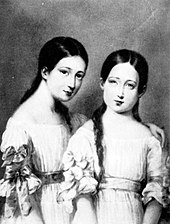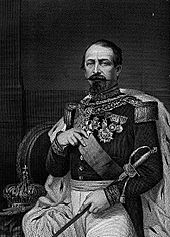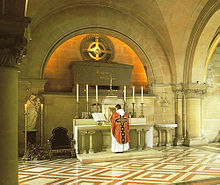Eugénie de Montijo

Eugénie de Montijo , in the long form María Eugenia Ignacia Agustina de Palafox Portocarrero de Guzmán y Kirkpatrick (born May 5, 1826 in Granada , † July 11, 1920 in Madrid ), was the wife of Napoleon III. from 1853 to 1870 Empress of the French and the last monarch of France.
Life
Early years
Eugénie de Montijo was born in Granada, the second daughter of Cipriano de Palafox y Portocarrero, the 13th Duke of Peñaranda del Duero, and his half-Scottish, half-Spanish wife Maria Manuela Kirkpatrick. The father fought on the French side for Joseph Bonaparte in the Napoleonic Wars on the Iberian Peninsula and was senator for the province of Badajoz in 1837/38 .
The poet Prosper Mérimée taught Eugénie together with her one year older sister Francisca "Paca" (1825-1860) in the French language. The Condesa de Teba, as Eugénie was called before their wedding, received a strictly Catholic upbringing in the convent of Sacré Coeur .
France's mother country

She met her future husband, whose attempts to initiate marriage with Adelheid zu Hohenlohe-Langenburg , the daughter of a half-sister of Queen Victoria , had just failed, at a ball in the Élysée Palace . On the occasion of the engagement speech on January 22, 1853, her future husband commented as follows:
"I prefer one woman I love and respect over another, with whom a relationship would have meant both advantages and sacrifices."
The British press reacted with amusement. She regarded this love marriage as too bourgeois for a ruling house. The British newspaper The Times wrote:
“We learn with a certain amusement that this romantic event aroused the greatest opposition in the annals of France and led to immeasurable irritation. The imperial family, the Council of Ministers and even the lower court employees regard this marriage as an incredible humiliation [...]. "
The civil wedding took place on January 23, 1853 in the Tuileries Palace; the church wedding on January 30th in the Notre-Dame cathedral of Paris .
On March 16, 1856, the Empress gave birth to a son, Napoléon Eugène Louis Bonaparte . Both this event and their beauty and elegance as well as their charm contributed significantly to the growing prestige of the imperial couple. She had a decisive influence on fashion - the fact that she bought models from Charles Frederick Worth supported his success as a fashion designer. Napoleon III often consulted with the intelligent and educated Eugénie. She acted as regent during his absence in 1859, 1865 and 1870 and pursued a decidedly conservative policy.
Eugénie became more and more involved in the political business, especially since the 1860s. Their position was decidedly conservative, clerical and authoritarian. She advocated an alliance with Austria - she was close friends with the Austrian ambassadors Prince and Princess Metternich - and vigorously advocated the preservation of the Papal States under French protection. She disliked the liberalization of the imperial government since 1861 and tried to influence her husband, who was eighteen years older than her, in a neo-absolutist direction. She advocated the invasion of Mexico in 1864 with Ferdinand Maximilian Joseph of Austria as Emperor of Mexico. On November 17, 1869, she inaugurated the Suez Canal in the presence of many princes and invited Europeans . In 1870 she was one of the avowed supporters of an armed conflict against Prussia and endeavored to the end for a pro-French intervention by Austria in the Franco-German War . After the defeat, she followed her husband into exile. She was not very popular with the French people - she was called l'Espagnole ("the Spaniard") - but was able to make a name for herself as a leader in fashion and style.
exile
After Napoléon III. was captured in the Battle of Sedan in the Franco-Prussian War, Eugénie fled Paris under adventurous circumstances with the help of the dentist Thomas W. Evans on September 5, 1870. First she traveled to Deauville by carriage , then to England by boat. On October 30th she visited Napoléon III. at Wilhelmshöhe Castle , Kassel, where he was placed under arrest as a prisoner of war.
From March 1871 she lived with her husband in exile in England. Napoleon III died in 1873 and Eugénie lived alternately in Farnborough , Hampshire , and in the villa "Cyrnos" (Greek name for Corsica ) on Cap Martin near Monaco . She also enjoyed staying in Luxor (Egypt) in a palatial villa on the Nile, which is now used as the luxury hotel "Winter Palace". She stayed completely away from French politics; when she was in Paris, she always stayed at the Hôtel Continental (3 rue de Castiglione).
She lived in seclusion until her death; however, she frequented the court of Queen Victoria , where she was treated with the ritual that was considered appropriate to an empress. The English composer Ethel Smyth witnessed a meeting between the British Queen and the French ex-Empress in 1893:
“On the doorstep the queen [...] indicated to the empress that she should go through before her; the Empress gracefully refused this. Then they both bowed deeply to each other. The movement of the queen, although already so severely handicapped, was astonishingly graceful; but the Empress, then sixty-seven, bent to the ground in a [...] deep and graceful gesture and rose again at the same moment [...] and then they stepped through the door together, practically shoulder to shoulder. "
Public appearances by the exiled empress were rare. One of the few exceptions was her participation in the world premiere of Mass in D , a work by Smyth quoted above, which she had composed mainly in her holiday home as a guest of the empress.
death
The Empress died in July 1920 at the age of 94 during a visit to her great-nephew, the Duke of Alba, in his Liria Palace in Madrid . She was buried in the imperial tomb in Saint Michael's Abbey in Farnborough, where her husband and her son, who died in the Zulu War in South Africa in 1879 , were also buried. She bequeathed her country estate in Spain to the descendants of her sister, the Duchess of Alba and Berwick, her English house at Farnborough Hill with furniture and collections to Prince Napoléon-Victor Bonaparte , her son's heir, the Villa Cyrnos not far from Monaco, where she spent her last years Prince Victor's sister, Princess Letizia , Duchess of Aosta and widow of the former King of Spain Amadeus I. 100,000 francs were earmarked for building the cathedral in Reims . Friends and servants received ample annuities. Many precious objects and mementos from the possessions of her husband and son have been donated to the museum in Malmaison . Many years later, a large part of her significant jewels came to the jewelry collector Aimee de Heeren, a Brazilian who also spent her summer months in Biarritz.
Aftermath
The asteroid (45) Eugenia was named in her honor, and the asteroid's Petit Prince moon commemorates her son.
literature
- Octave Aubry: L'Impératrice Eugénie. Paris 1937.
- Ernest Barthez: The empress Eugènie and her circle. Fisher Unwin, London 1912.
- Harold Kurtz: Eugenie. The Empress of the French. Wunderlich, Tübingen 1964.
- Maurice Paléologue : Confidential talks with the Empress Eugénie. Aretz, Dresden 1928.
- Desmond Seward: Eugènie. The empress and the empire. Stroud, Sutton 2004, ISBN 0-7509-2979-0 .
Web links
- Literature by and about Eugénie de Montijo in the catalog of the German National Library
- Newspaper article about Eugénie de Montijo in the 20th century press kit of the ZBW - Leibniz Information Center for Economics .
- Signs of time : May 5, 1826 - Empress Eugénie's birthday
Individual evidence
- ↑ Cf. Octave Aubry : L'impératrice Eugénie. Fayard, Paris 1931.
- ↑ http://tscheiar.ch/47312/117364.html: memorial plaque. Retrieved July 8, 2019 .
- ↑ Ethel Smyth: A Stormy Winter. Memories of a contentious English composer. Bärenreiter, Kassel 1988, ISBN 3-7618-0923-9 .
- ↑ The Marguerites of the Empress and Aimee de Heeren
- ↑ 100 years later, various photos of Aimee de Heeren with the empress's jewelry ( memento of the original from January 10, 2015 in the Internet Archive ) Info: The archive link was inserted automatically and has not yet been checked. Please check the original and archive link according to the instructions and then remove this notice.
| personal data | |
|---|---|
| SURNAME | Montijo, Eugénie de |
| ALTERNATIVE NAMES | Maria Eugénia Ignacia Augustina Palafox de Guzmán Portocarrero y Kirkpatrick |
| BRIEF DESCRIPTION | Empress of France (1853–1871), wife of Napoléon III. |
| DATE OF BIRTH | May 5, 1826 |
| PLACE OF BIRTH | Granada |
| DATE OF DEATH | July 11, 1920 |
| Place of death | Madrid |





